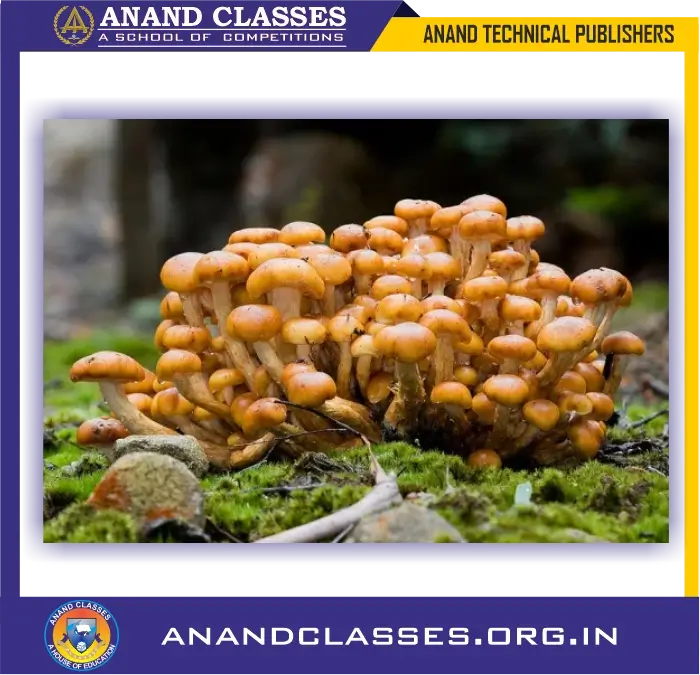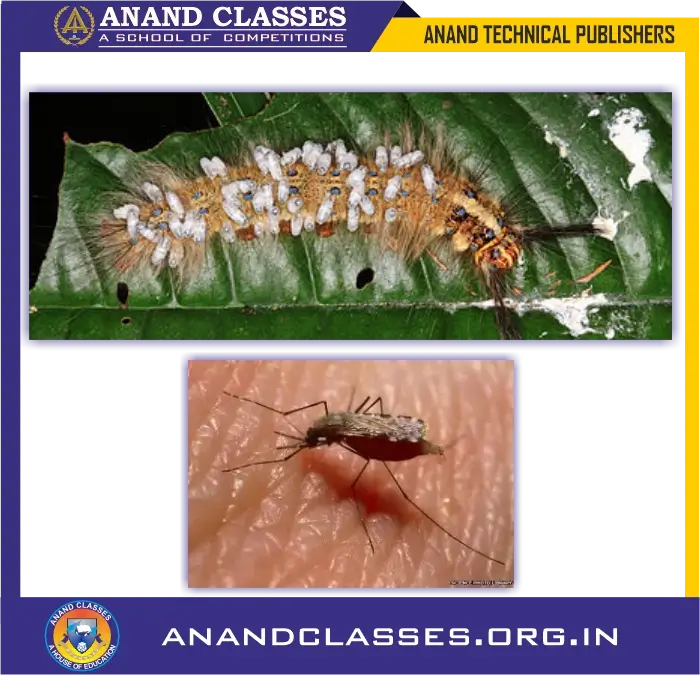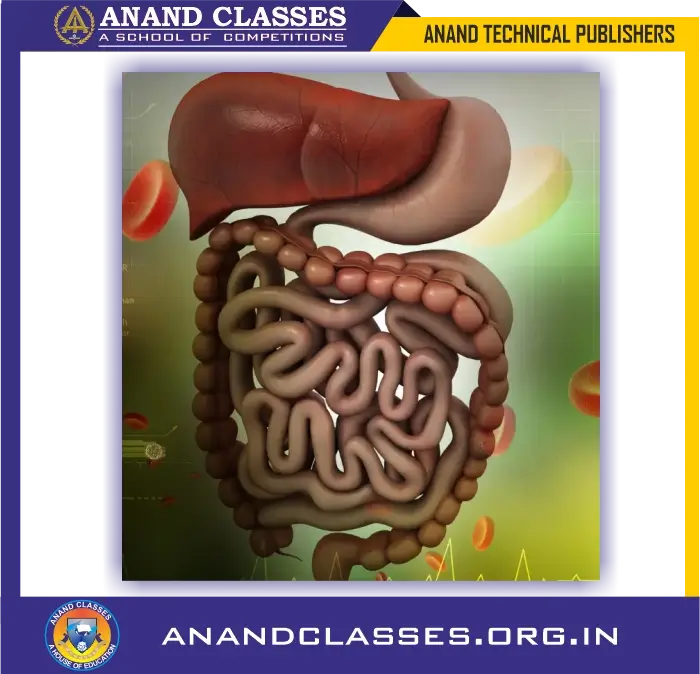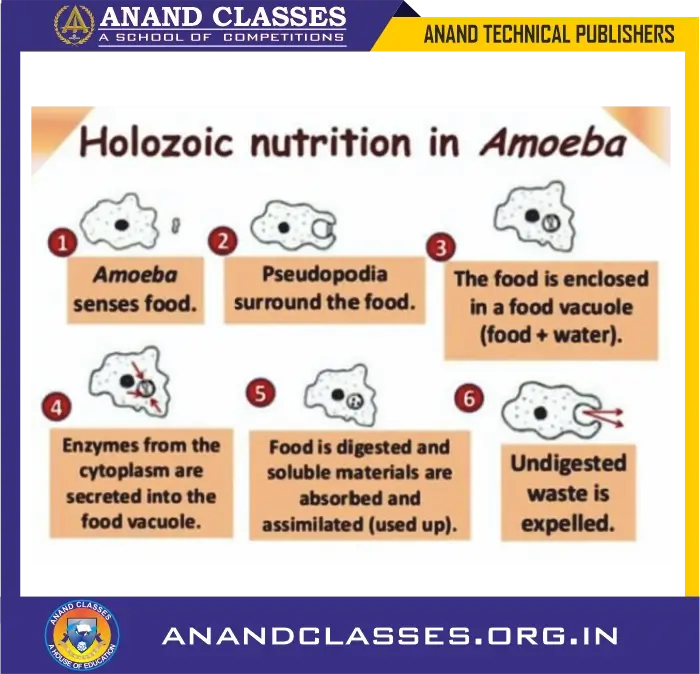ANAND CLASSES Study Material and Notes to learn the different types of heterotrophic nutrition, including saprotrophic, parasitic, and holozoic nutrition for NEET Foundation and CBSE Class 10 Science(Biology). Learn their characteristics, examples, and significance in nature with FAQs, conceptual questions, and a test paper.
Types of Heterotrophic Nutrition
A heterotrophic organism (or heterotroph) obtains its food from other organisms. The heterotrophic mode of nutrition is classified into three types:
- Saprotrophic nutrition
- Parasitic nutrition
- Holozoic nutrition
1. Saprotrophic Nutrition (or Saprophytic Nutrition)
Definition:
Saprotrophic nutrition is a mode of nutrition in which an organism derives its food from decaying organic matter such as dead plants, dead animals, and rotten bread.

nutrition. This picture shows mushrooms obtaining
their food from the rotting wood of a dead tree.
Characteristics of Saprotrophic Nutrition:
- Organisms feed on dead and decaying matter.
- They release digestive enzymes that break down complex organic molecules into simpler substances.
- The simpler substances are absorbed as food.
- Saprotrophic nutrition is also called saprophytic nutrition.
- It plays an important role in the decomposition of organic matter.
- It helps in nutrient recycling in the environment.
Examples of Saprotrophic Organisms:
- Fungi: Bread moulds, mushrooms, yeast
- Bacteria: Many bacterial species exhibit saprotrophic nutrition
Process of Saprotrophic Nutrition:
- Enzymes are secreted onto dead organic material.
- Enzymes break down the complex molecules into simpler molecules.
- The organism absorbs the simpler substances as nutrients.
Importance of Saprotrophic Nutrition:
- Helps in decomposition and recycling of nutrients.
- Maintains ecological balance by breaking down dead matter.
- Used in industries like fermentation (e.g., yeast in bread making).
2. Parasitic Nutrition
Definition:
Parasitic nutrition is a mode of nutrition in which an organism derives its food from another living organism (the host) without killing it.

obtains the food is called a ‘parasite’, and the organism from
whose body food is obtained is called the ‘host
Characteristics of Parasitic Nutrition:
- A parasite is an organism that feeds on another living organism called the host.
- The host provides food but does not receive any benefit in return.
- Parasites often harm their hosts.
- Parasites can be found in plants, animals, and microorganisms.
- Some parasites live inside the host’s body (endoparasites), while others live outside (ectoparasites).
Examples of Parasites:
- Microorganisms: Plasmodium (causes malaria), bacteria causing diseases
- Plants: Cuscuta (Amarbel) lacks chlorophyll and depends on the host plant for nutrients.
- Animals: Roundworms, tapeworms, lice, ticks, leeches
Effects of Parasitic Nutrition:
- Causes diseases in humans, animals, and plants
- Leads to malnutrition in the host
- Can weaken or kill the host over time
3. Holozoic Nutrition
Definition:
Holozoic nutrition involves the ingestion of solid food, digestion into simpler substances, absorption into the body, and egestion of waste materials.

most of the animals have a holozoic mode of nutrition.
Characteristics of Holozoic Nutrition:
Holozoic nutrition occurs in organisms that consume solid or liquid food, digest it, absorb nutrients, and eliminate waste. It involves five main steps:
1. Ingestion (Intake of Food)
- The organism takes in food from its surroundings.
- Example: Amoeba engulfs food using pseudopodia; humans use the mouth for ingestion.
2. Digestion (Breaking Down of Food)
- The complex food molecules are broken down into simpler, absorbable forms.
- It can be intracellular (inside cells, e.g., Amoeba) or extracellular (outside cells, e.g., humans).
- Enzymes play a crucial role in this step.
3. Absorption (Nutrient Uptake)
- The digested nutrients are absorbed into the bloodstream (in multicellular organisms) or directly into the cytoplasm (in unicellular organisms).
- Example: In humans, absorption occurs mainly in the small intestine.
4. Assimilation (Utilization of Nutrients)
- The absorbed nutrients are used for energy, growth, and repair of body tissues.
- The glucose obtained is used in cellular respiration to release energy (ATP).
5. Egestion (Removal of Waste)
- The undigested and unabsorbed food is removed from the body.
- Example: Amoeba expels waste through exocytosis, while humans eliminate it as feces through the anus.
This process ensures that organisms obtain the energy and nutrients needed for survival.
Examples of Holozoic Organisms:
- Humans and Animals: Dog, cat, tiger, lion, deer, giraffe, bear
- Protozoans: Amoeba
Process of Holozoic Nutrition in Amoeba:
Amoeba follows holozoic nutrition, which involves five main steps: ingestion, digestion, absorption, assimilation, and egestion.
1. Ingestion (Intake of Food)
- Amoeba engulfs food particles (e.g., microscopic organisms like bacteria and algae) using its pseudopodia (false feet).
- The pseudopodia surround the food, forming a food vacuole (phagosome).
2. Digestion (Breaking Down of Food)
- Enzymes from lysosomes are released into the food vacuole.
- These enzymes break down complex food substances into simpler, soluble forms.
3. Absorption (Nutrient Uptake)
- The digested nutrients are absorbed into the cytoplasm.
- These nutrients are used for energy, growth, and repair.
4. Assimilation (Utilization of Nutrients)
- The absorbed nutrients are used for various cellular functions.
- Energy is released through respiration, helping in movement and reproduction.
5. Egestion (Removal of Waste)
- The undigested food particles are expelled by exocytosis.
- The cell membrane opens at any point to release waste outside the body.
Diagram of Holozoic Nutrition in Amoeba
You can visualize this as a stepwise process where the Amoeba engulfs food, digests it, absorbs nutrients, and expels waste.

Importance of Holozoic Nutrition:
- Provides energy for growth and survival.
- Essential for the maintenance of body functions.
- Supports higher organisms like humans and animals.
Frequently Asked Questions (FAQs)
Q1: What is heterotrophic nutrition?
A: Heterotrophic nutrition is a mode of nutrition in which organisms obtain food from other living or dead organisms.
Q2: How does saprotrophic nutrition help in nature?
A: Saprotrophic organisms decompose dead matter and recycle nutrients back into the ecosystem.
Q3: What is the difference between parasitic and saprotrophic nutrition?
A:
- Parasitic organisms feed on living organisms (host), often harming them.
- Saprotrophic organisms feed on dead and decaying matter.
Q4: Why is holozoic nutrition important?
A: Holozoic nutrition enables organisms to consume, digest, and absorb complex food materials for energy and growth.
Do You Know?
- Fungi like mushrooms grow on dead tree trunks and help in decomposition.
- Ticks and lice suck blood from animals and humans as parasites.
- Amoeba uses pseudopodia (false feet) to engulf food particles.
- Parasitic plants like Cuscuta lack chlorophyll and cannot perform photosynthesis.
- Roundworms and tapeworms live inside the intestines of animals and absorb nutrients.
Worksheet
Fill in the blanks:
- The mode of nutrition in which organisms feed on dead matter is called _________.
- _________ is an example of a parasitic plant.
- The five steps of holozoic nutrition are _______, _______, _______, _______ and _______.
True or False:
- Amoeba has a parasitic mode of nutrition. (False)
- Mushrooms obtain food from dead and decaying matter. (True)
Test Paper (Marks Distribution)
Section A: Multiple Choice Questions (1 mark each)
- Which of the following is a saprophytic organism? a) Plasmodium
b) Amoeba
c) Yeast
d) Roundworm - What type of nutrition does Cuscuta follow? a) Holozoic
b) Saprotrophic
c) Parasitic
d) Autotrophic
Section B: Short Answer Questions (2 marks each)
- Explain the term “parasitic nutrition” with examples.
- Why is saprotrophic nutrition important for the ecosystem?
Section C: Long Answer Questions (5 marks each)
- Differentiate between saprotrophic, parasitic, and holozoic nutrition with examples.
- Describe the steps involved in holozoic nutrition with a labeled diagram.
Important Points for Quick Revision
- Saprotrophic Nutrition: Organisms break down dead material externally using enzymes.
- Parasitic Nutrition: Parasites feed on a living host, often harming it.
- Holozoic Nutrition: Involves ingestion, digestion, absorption, assimilation, and egestion.
- Examples: Fungi (saprotrophic), Cuscuta (parasitic), Humans (holozoic).
- Saprophytes help in decomposition, parasites cause diseases, and holozoic nutrition provides energy to animals.
🔷 Best Coaching Center for IIT-JEE, NEET, and Foundations
🔹 ANAND CLASSES – The best coaching institute for JEE, NEET, and Class 11-12 Foundations.
🔹 Buy complete study material at 👉 https://publishers.anandclasses.co.in/
🔹 Proprietor: NIRMAL ANAND Educations
🔹 Written by: Neeraj Anand
🔹 Published by: Anand Technical Publishers under Anand Classes
📞 Contact: +91-9463138669
📧 Email: anandclasses1996@gmail.com



